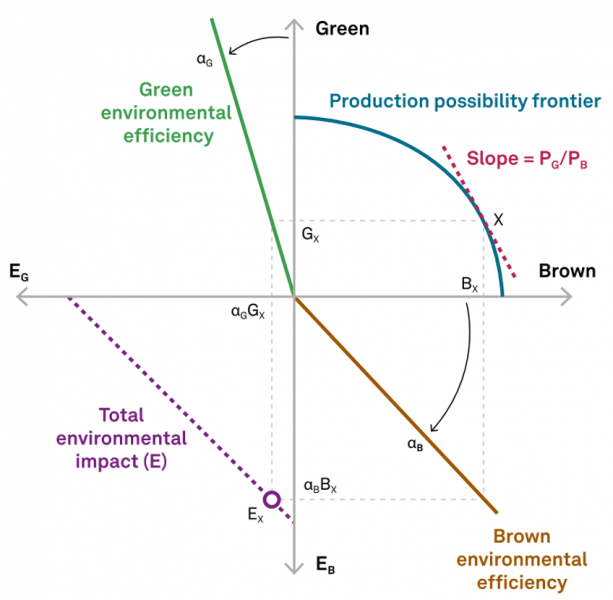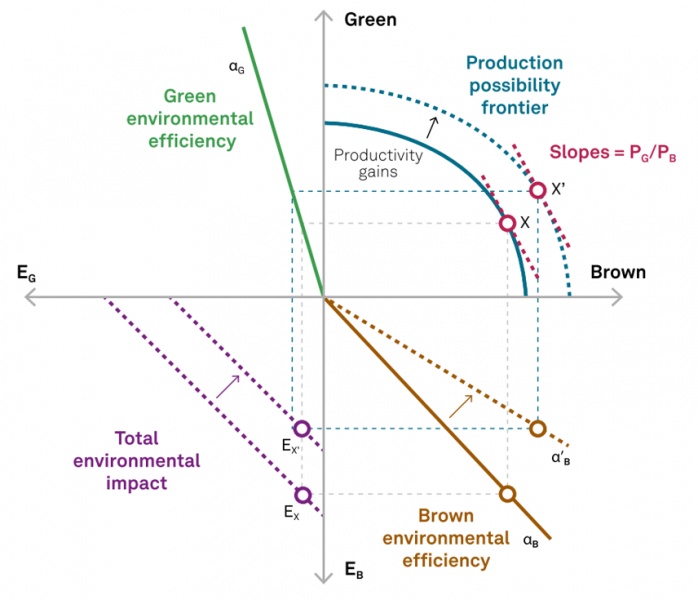

Growth models typically focus on the accumulation of physical and human capital, implicitly taking the environment or natural capital as given. This omission has recently come to the fore and raises a critical question: is growth even possible without damaging the environment? In this paper we present a simple two-sector “green-brown” model that explicitly incorporates the trade-off between economic activity and the environment. Here, more is not automatically better and several standard views about growth (such as the demographic dividend) come into question. Green growth is possible but arises only when it stems from technologies that reduce the environmental footprint of production.
How can we get to a net-zero environmental impact and still achieve economic growth if any type of economic activity can hurt the environment in some fashion? One conclusion is that the economic pie must shrink in order to reverse or just contain the deterioration of the environment that has accelerated in recent decades.
A more hopeful outcome is that some combination of better pricing and technological improvements could make sustainable economic growth possible. To explore these trade-offs, we developed a simple framework to show the interaction between economic output and its environmental impact: both negative and positive. The model serves as a tool to explore under what conditions green growth, by which we mean expansion of output that does not have an increasingly negative environmental impact, might take place, focusing on a few key variables.
Our two-sector model can be described by the chart below (Chart 4 of the full paper). Technology, along with the preferences of the individuals, jointly and uniquely determines the laissez-faire equilibrium X of the economy. Under the usual assumptions on preferences, this equilibrium requires the production of positive output level for all sectors (BX for the brown sector, GX for the green one).
The innovation in this model is to translate these sectoral outputs into an environmental impact. For simplicity, we posit a linear environmental efficiency relation for each of these sectors (damage due to production is a sector-specific constant multiplied by the level of production). Total damage E is the sum of damages imposed by both sectors. The environment is indifferent to which sector causes damage – for example, think of damage being measured in CO2 units emitted. All notions developed in this paper can be generalized to N sectors but are more easily represented in this two-sector model.
Chart 1: Equilibrium output and the environmental impact

Source: S&P Global Ratings.
The building blocks of achieving green growth – as well is its challenges – can be seen directly in this framework using basic comparative statics (a fuller description is in the main paper).
Given that growth in this model corresponds to a continued outward shift in the production possibilities of the economy, how to achieve green growth? We just showed that shifting out the PPF leads to a higher, worse environmental outcome. But we also showed that changes in other key variables can result in an improvement in the environment. We now have the pieces in place to show that bringing down the damage done to nature does not require degrowth.
Green growth requires a combination of higher output and a lower environmental impact from that output. In our framework, two things need to happen at the same time for this to take place. First, the PPF needs to shift out from an increase in endowments or more productive technology. Second, the environmental impact of production needs to decline. An example of this is shown in the chart below.
Chart 2: Green growth that reduces the environmental impact

Source: S&P Global Ratings.
Consider an innovation where the production technology improves, shifting out the PPF. If this innovation coincides with a higher environmental efficiency in either sector (brown is shown) then we have both higher output and a lower environmental impact. Note that technology has two interpretations in this model, and both are important: it can increase output for a given set of inputs, and it can lower the environmental impact from output. If this fortuitous combination is repeated over time, then we have green growth.
Such combinations are indeed plausible. Think about how computers have fewer and smaller components compared in their predecessors. This affects both the PPF (more computing output) and the environmental efficiency of the sector. Electric cars might qualify as well. They have fewer components than combustion cars so “transportation services” can be produced more efficiently. And, they have lower emissions so are better for the environment.
Note that green growth is compatible with improved efficiencies in the brown sector as well as the green sector. Indeed, given the starting points of environmental efficiencies, moving from brown to beige rather than green might be a better strategy in some cases. There is more room for (sustained) improvement. To put this in real world terms, modern society is based on concrete, steel, plastics, and ammonia, all of which are in the brown sector.
So far, we have linked output to its environmental impact, but we have not addressed the issue of sustainability. The (gross) environmental impact, denoted as E, resulting from production in our model may or may not be compatible with sustainability or net zero. We need more structure to answer this.
To assess whether green growth is compatible with our environmental goals, we first need to state them. The simplest way to do so is to fix a target E* – typically, the net zero level – of damage which is deemed acceptable or sustainable. If E is always positive (think of gross emissions), how does this work?
The key to deriving E* is to recognize that the effects of emissions can be reduced. This can occur in several ways. The first is through nature. There is a regenerative or healing element to natural capital, which can absorb carbon and at least potentially offset its effects on the environment. The pandemic showed this with cleaner air and the return of wildlife to New York City of all places. This effect can be bolstered by deliberate efforts such as rewilding or maintaining or re-planting carbon absorbing forests. A second way is through technology, such as direct air capture. This may not be part of any particular production process but can help to decarbonize none the less.
How do we formalize this? Let us call the first effect RN to denote regeneration through nature. And let us call the second effect RT to denote regeneration through technology. We can use these concepts to think about net zero. Specifically, our economy is producing “net zero” or sustainable emissions when E* = RN + RT. If E > RN + RT either E needs to fall, or we need to increase regeneration. In the absence of calibration in our model, we show some illustrative scenarios in chart 3.
Chart 3: Illustrative Configurations of Net Zero

In an initial position, the environmental impact of the economy E is not offset by the sum of the two generation effects, so the position is not sustainable. In equilibrium A, net zero is achieved entirely by lowering E. This would happen through some combination of the following levers:
But there are other possible, more complex paths to net zero as well. Equilibrium B features an increase in RT, for example through direct air carbon capture, reducing the adjustment needed by E, which needs to fall by less than in Equilibrium A. Depending on the extent to which RN and RT are increased, E needs to fall by less (in some arguably extreme cases it may not need to fall at all in this model).
We agree with the challenge of attaining green growth, but not necessarily with the pessimism voiced by some. In this paper, we have developed a framework to highlight the trade-offs between growth and the environment and map out the paths of potential progress. The structure of our model illustrates that the pursuit of economic growth does not automatically translate into economic prosperity (higher welfare) once we consider the environmental impact. But it also shows that sustainable or green growth is possible.
The model implies that continuous innovation, rather than reducing output, is the best way to minimize the adverse impact of economic activity on the environment. Importantly, innovation in this model means not only making the economy more productive (the traditional interpretation) but also shrinking the environmental footprint of production. We already see this with the growth of renewable energy generation as well as the decarbonization of certain brown sectors.
Last but not least, getting to green growth requires a full accounting of the environmental impact of production. This, in turn, will help policymakers and markets move toward a pricing structure that guides spending and output onto a path where growth is both efficient and sustainable.